The Arabian Gulf countries
 |
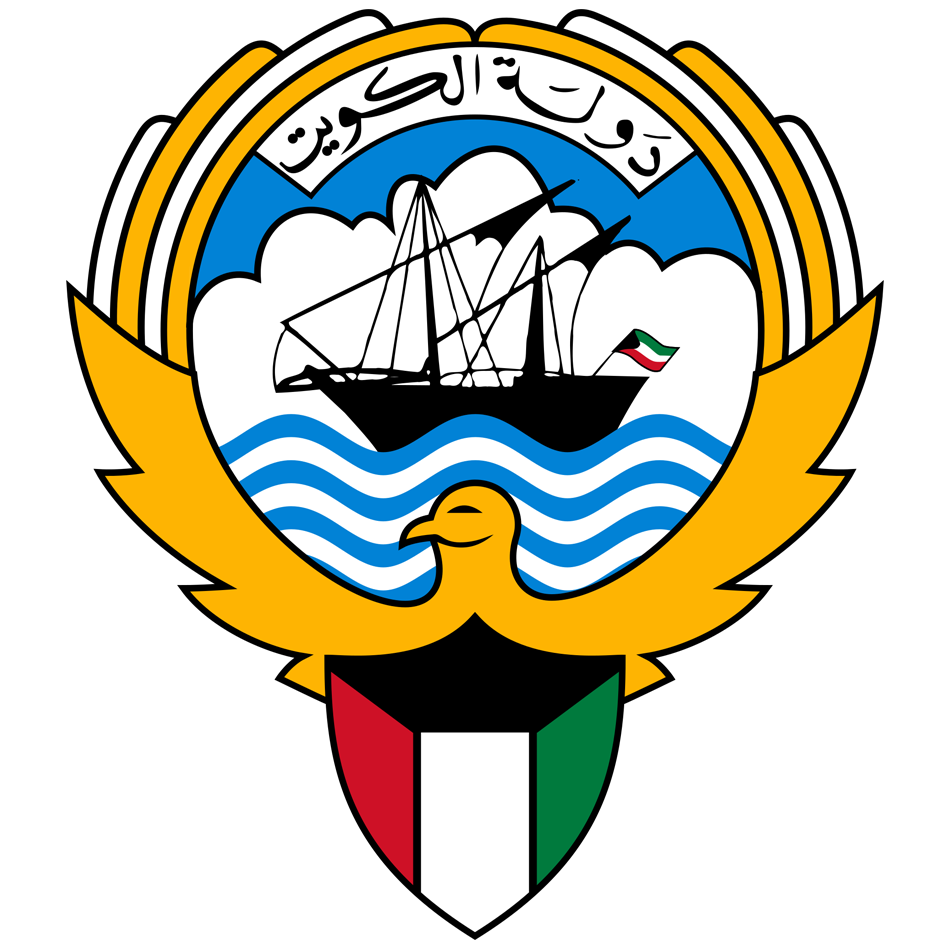 |
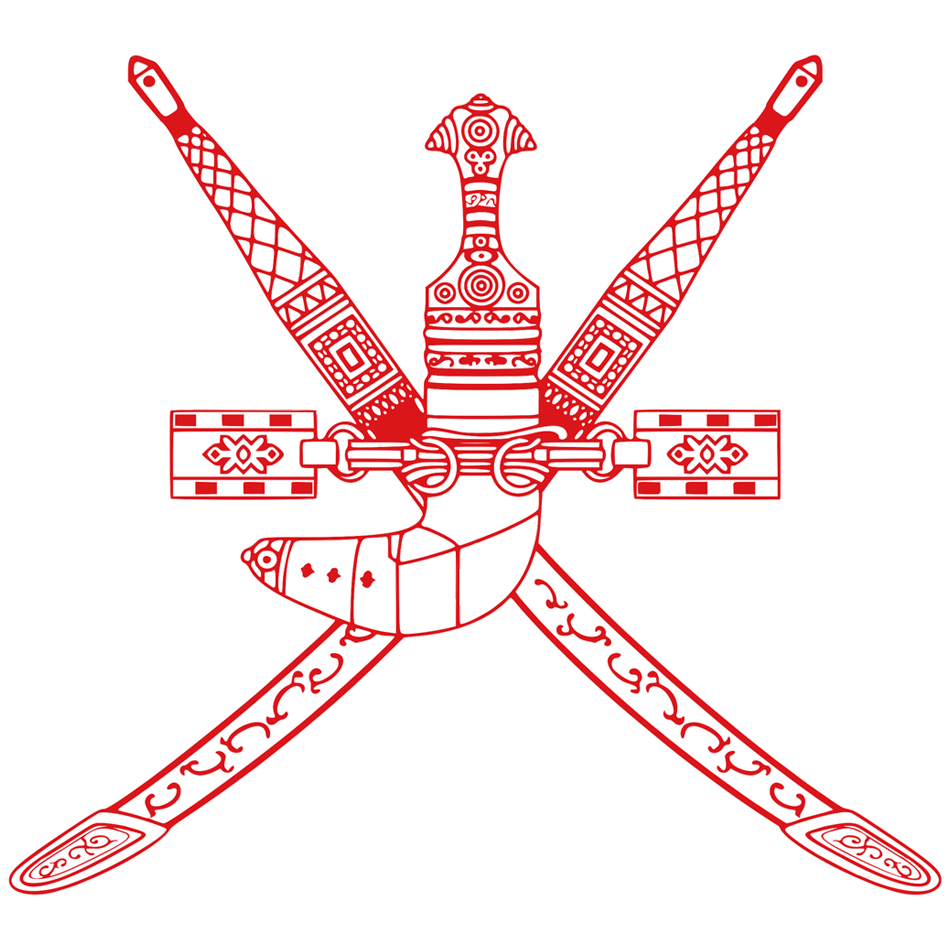 |
 |
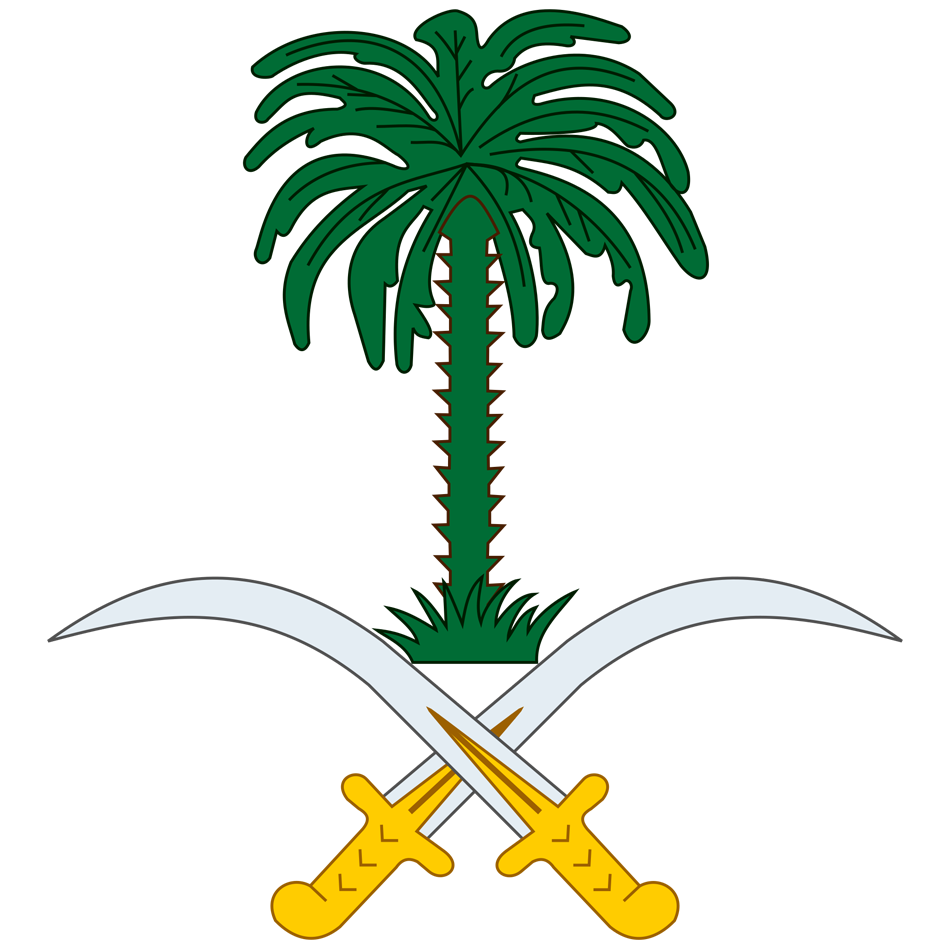 |
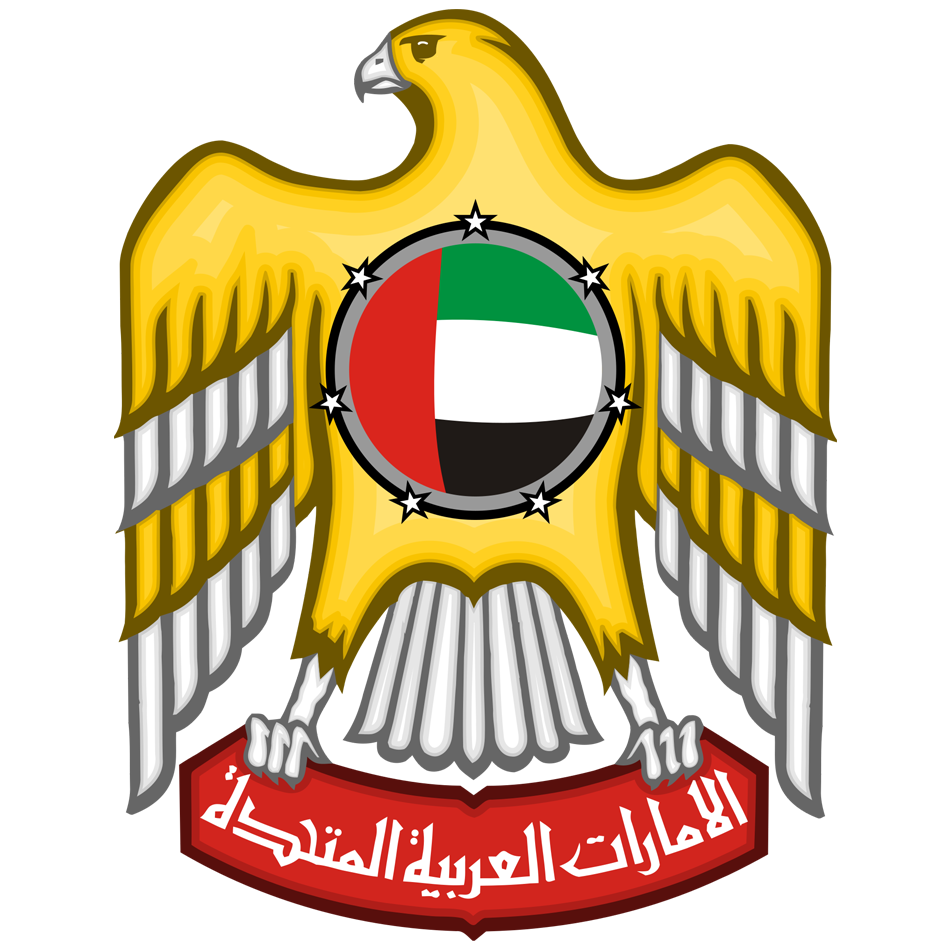 |
The Gulf Cooperation Council
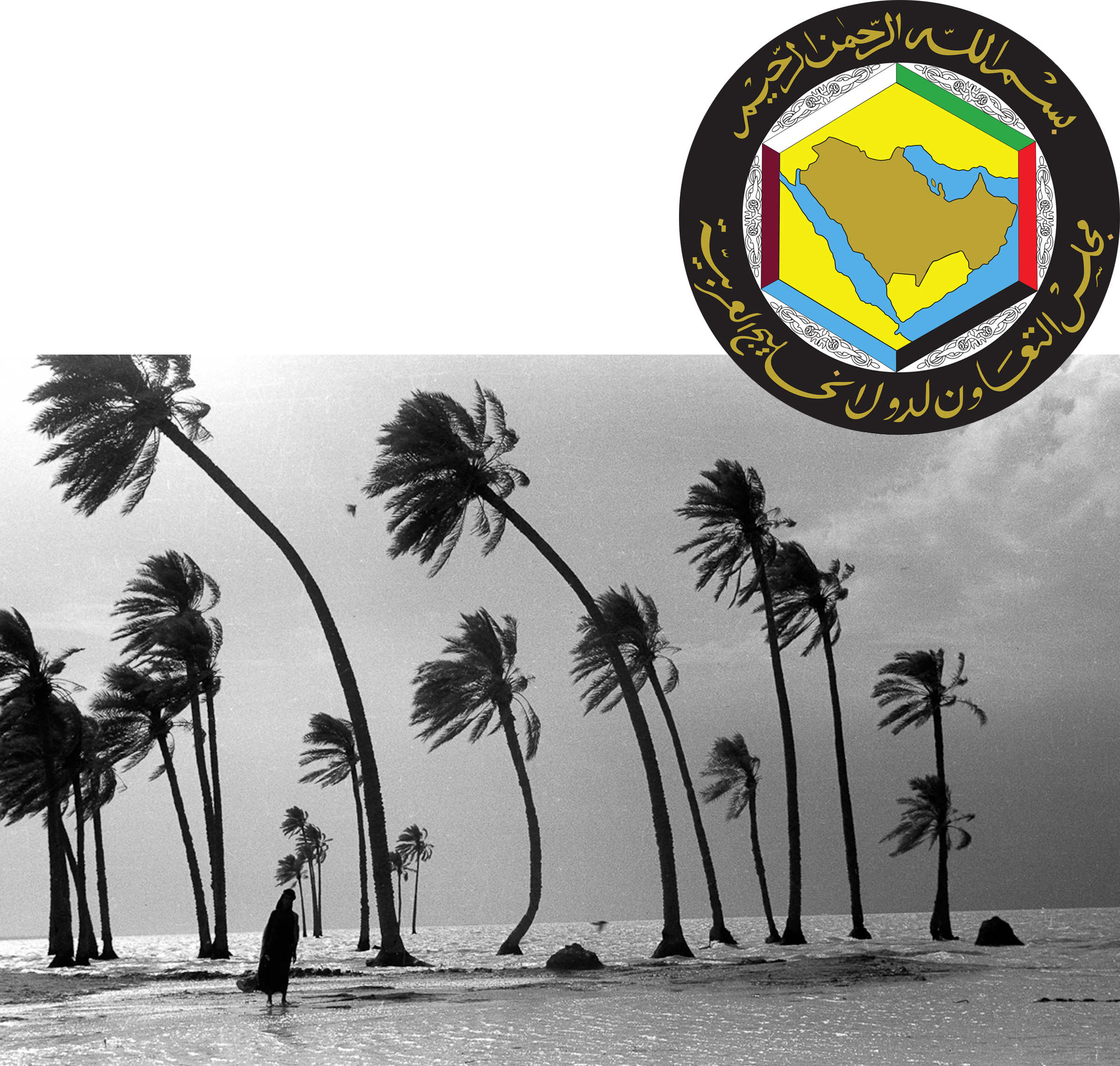

The Gulf Cooperation Council (GCC) is a regional, intergovernmental, political, and economic union made up of Bahrain, Kuwait, Oman, Qatar, Saudi Arabia, and the United Arab Emirates (UAE) and came into being after signing a joint charted on the 25th of May, 1981. The GCC, not surprisingly, is headquartered in the Saudi capital, Riyadh. Saudi Arabia is by far the most populous of the six Arabian Gulf states. These six countries have long been viewed analytically as broadly similar to one another and were once labelled by the World Bank as being “resource-rich [but] labour poor.”
The Arabian Gulf countries
Since the late 1990s, the Arabian Gulf has undergone rapid socioeconomic change. From 1998, the region’s real GDP has expanded by an annual average of around five per cent to date. Over the same period, the population has risen from just over 28 million to 59 million (as of 2025). What makes the region unique demographically-speaking, is that of the current population, only 43 per cent are Gulf citizens (Khaleeji, Arabic: خليجي, meaning: “people of the gulf”). Of the 25 million Khaleejis, around three-quarters are Saudi nationals (see: Arabian Gulf data). At the other end of the spectrum, there are only several hundred thousand Qatari citizens. Qataris are by far and away the richest in per capita PPP GDP terms anywhere in the world (most, if not all, international rankings institutions do not delineate between nationals (i.e., Qataris) and the country’s large pool of temporary “guest workers” (i.e., non-nationals) when compiling their annual league tables, based on IMF datasets).
With the exception of Oman and Saudi Arabia, the citizenries of all Gulf countries are in the minority (relative to their respective pools of expatriate residents) and, as a consequence, rely heavily on non-national labour to carry out all manner of work. In Qatar and the UAE, nationals only make up a small fraction of their respective workforces (five and nine per cent respectively; and in terms of the real private sector comprise only a few percentage points at most).
According to the IMF (2024), the GCC countries have “successfully weathered recent turbulence in the Middle East, and their economic prospects remain favorable.” Their analysis suggests that non-hydrocarbon activity has been strong amid reform implementation, although overall growth has decelerated due to cuts in oil production. The growth outlook is positive for the (2025–2028 period), as the envisaged easing of oil production cuts and natural gas expansion spur the recovery in the hydrocarbon sector, while the nonhydrocarbon economy is forecast to continue growing.
Democracy indices
The EIU’s “Democracy Index” is currently published annually. It seeks to measure “the quality of democracy” globally, focusing on “democratic rights and democratic institutions.” Based on 60 indicators, the EIU index is grouped into five categories: electoral process and pluralism; functioning of government; political participation; political culture; and civil liberties” [and] based on their average score, each country is classified as one of four types of regimes: “full democracies”, “flawed democracies”, “hybrid regimes” and “authoritarian regimes.”
The following Tables are all ordered by their overall democracy score (2016–2021), aside from those for 2022 and 2023; these simply order the included Middle Eastern countries alphabetically.
2023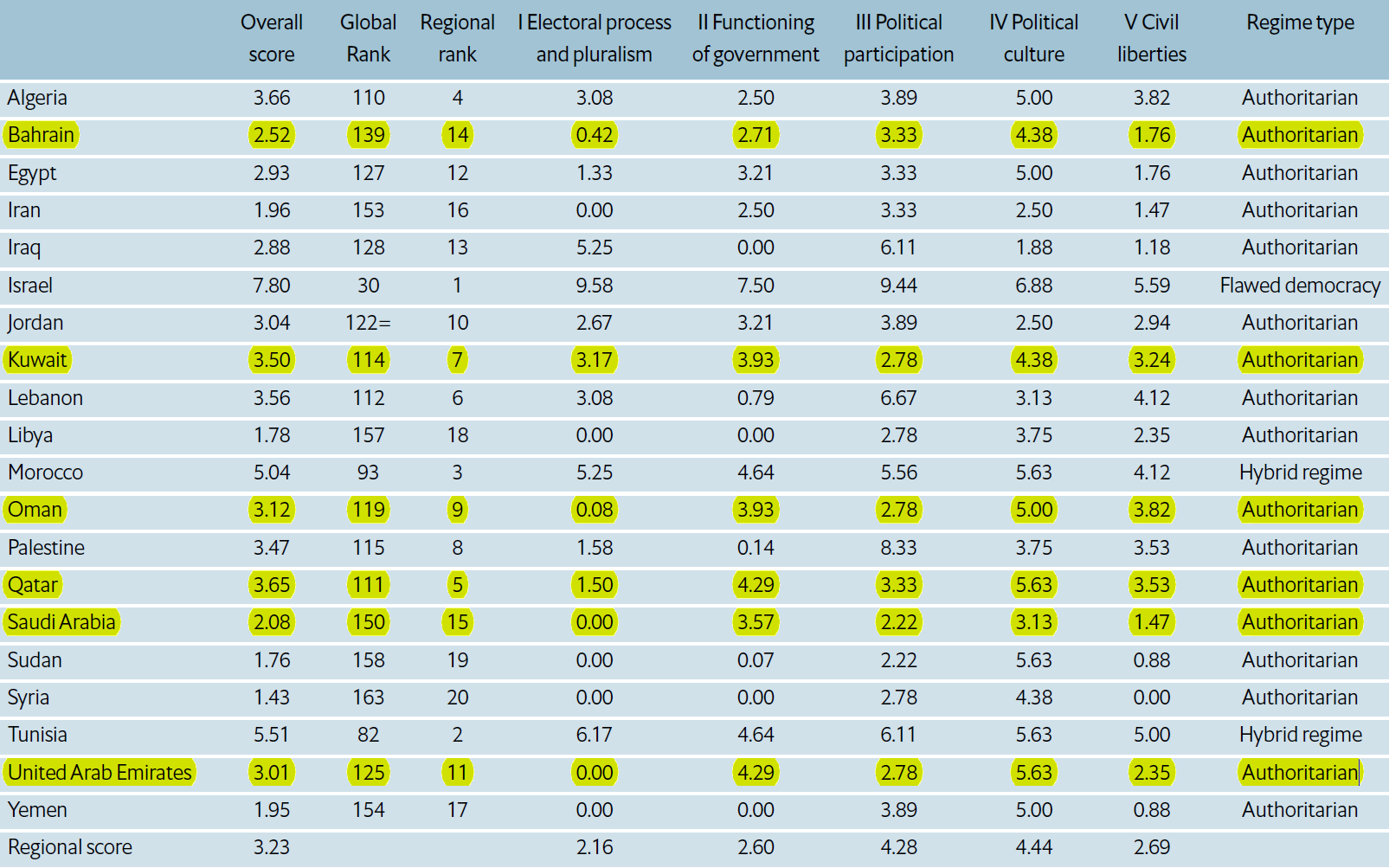
2022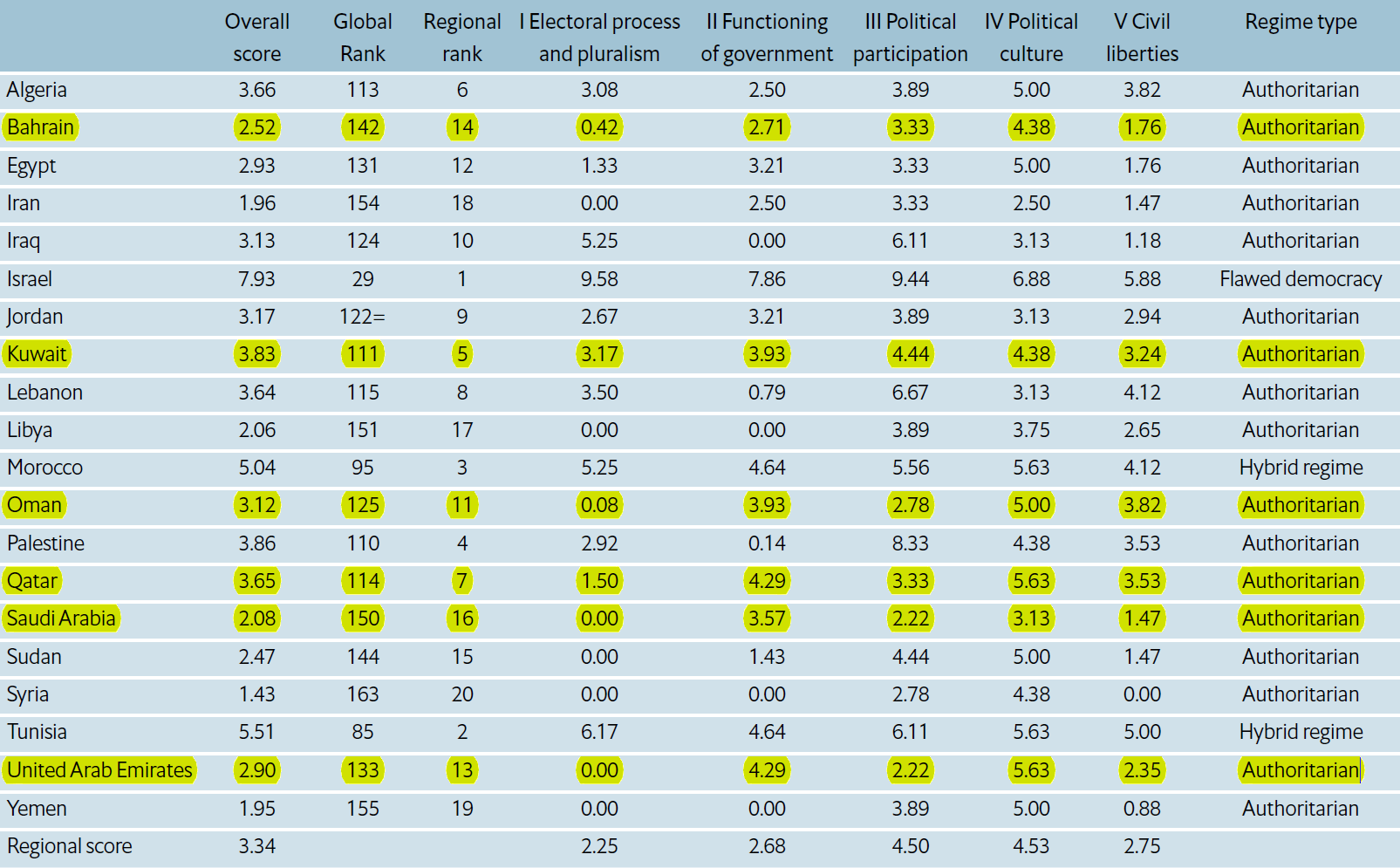
2021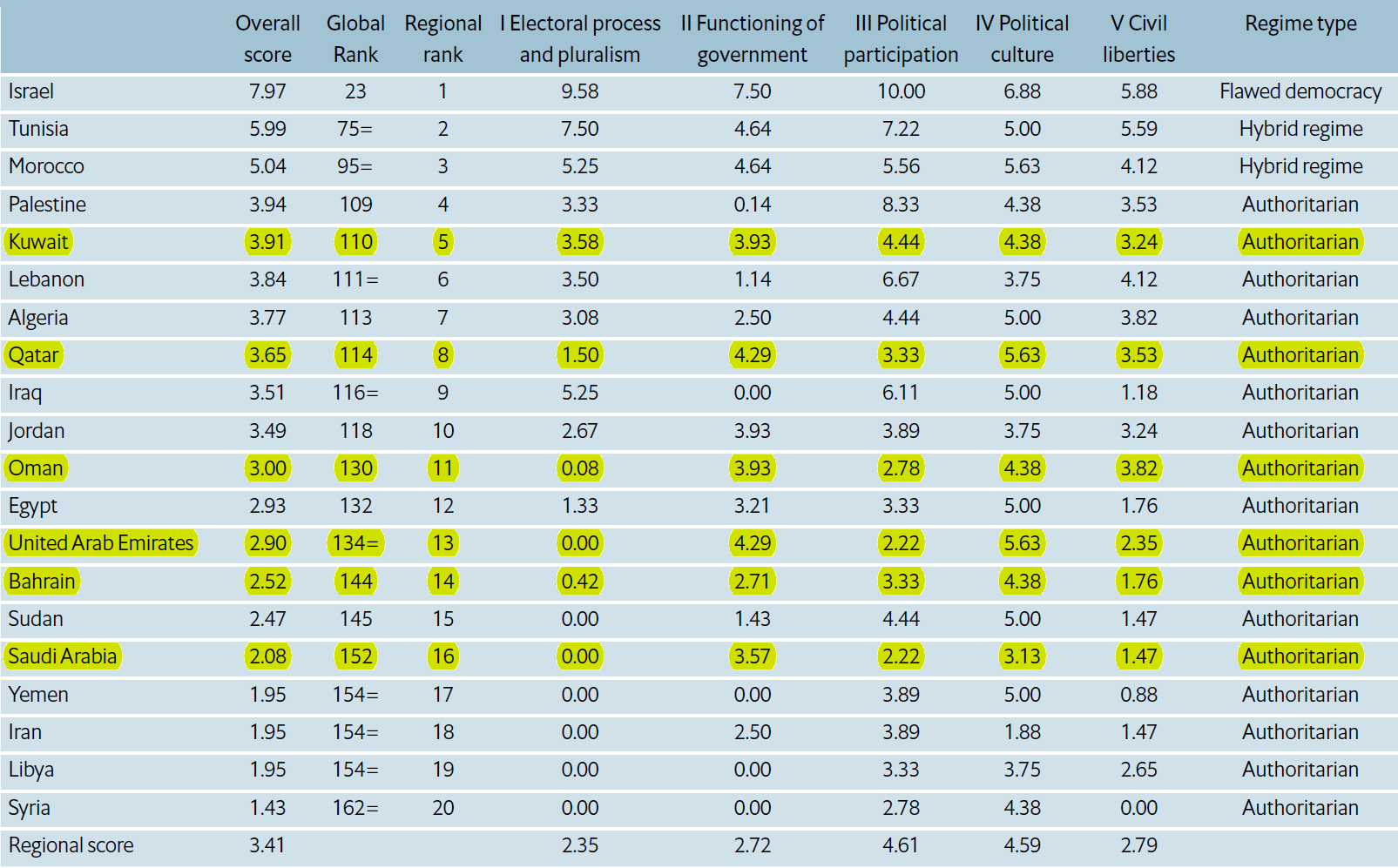
2020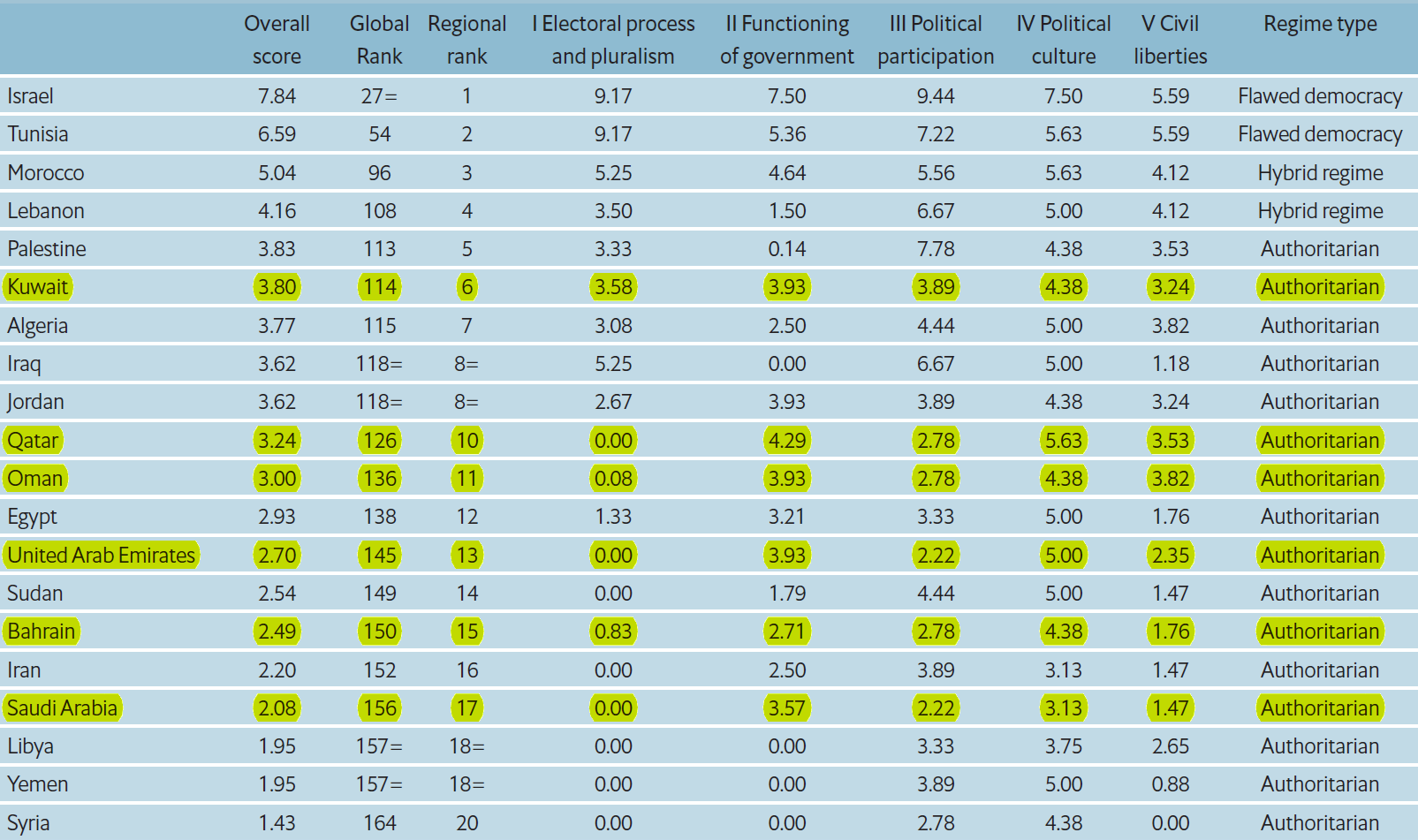
2019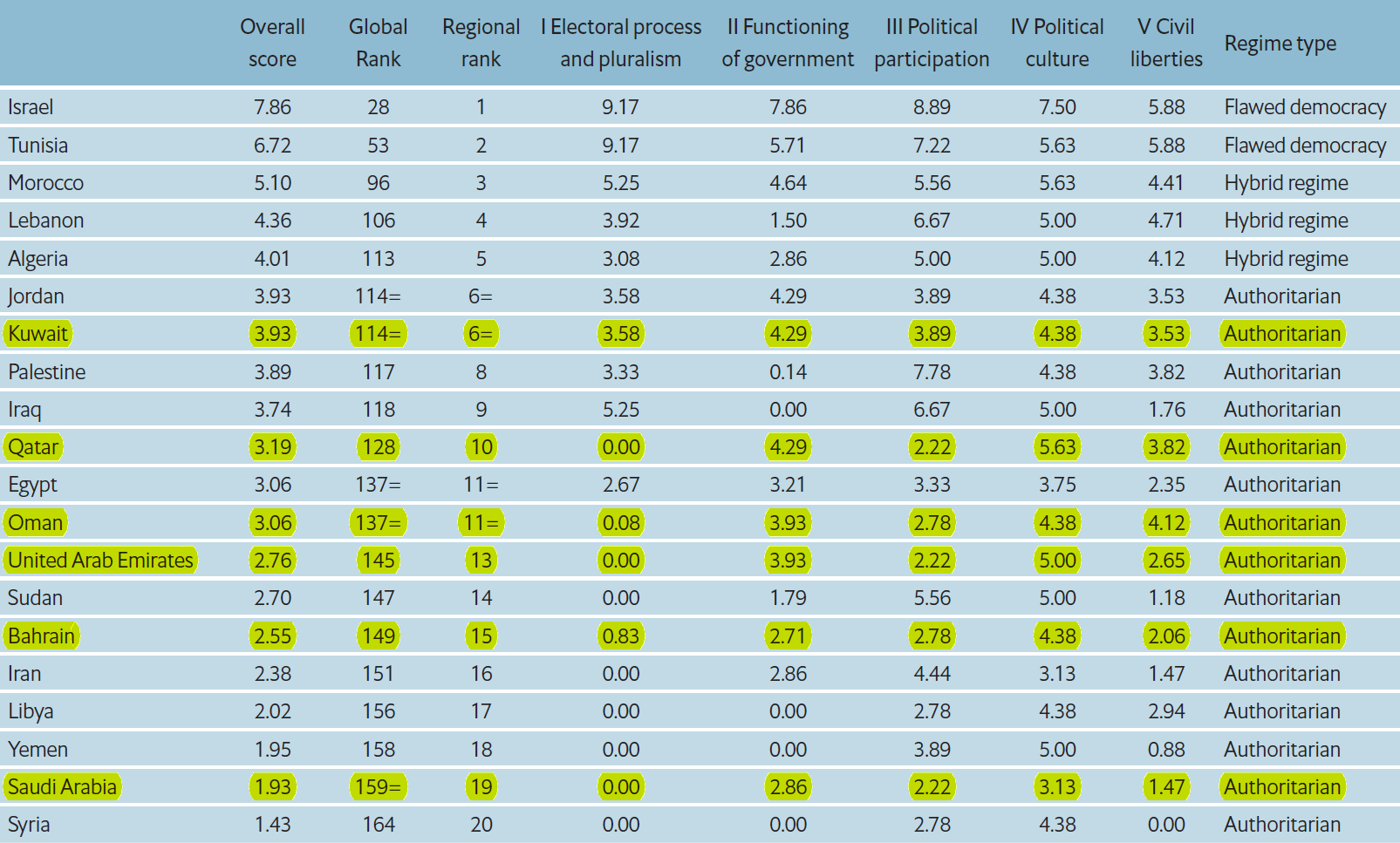
2018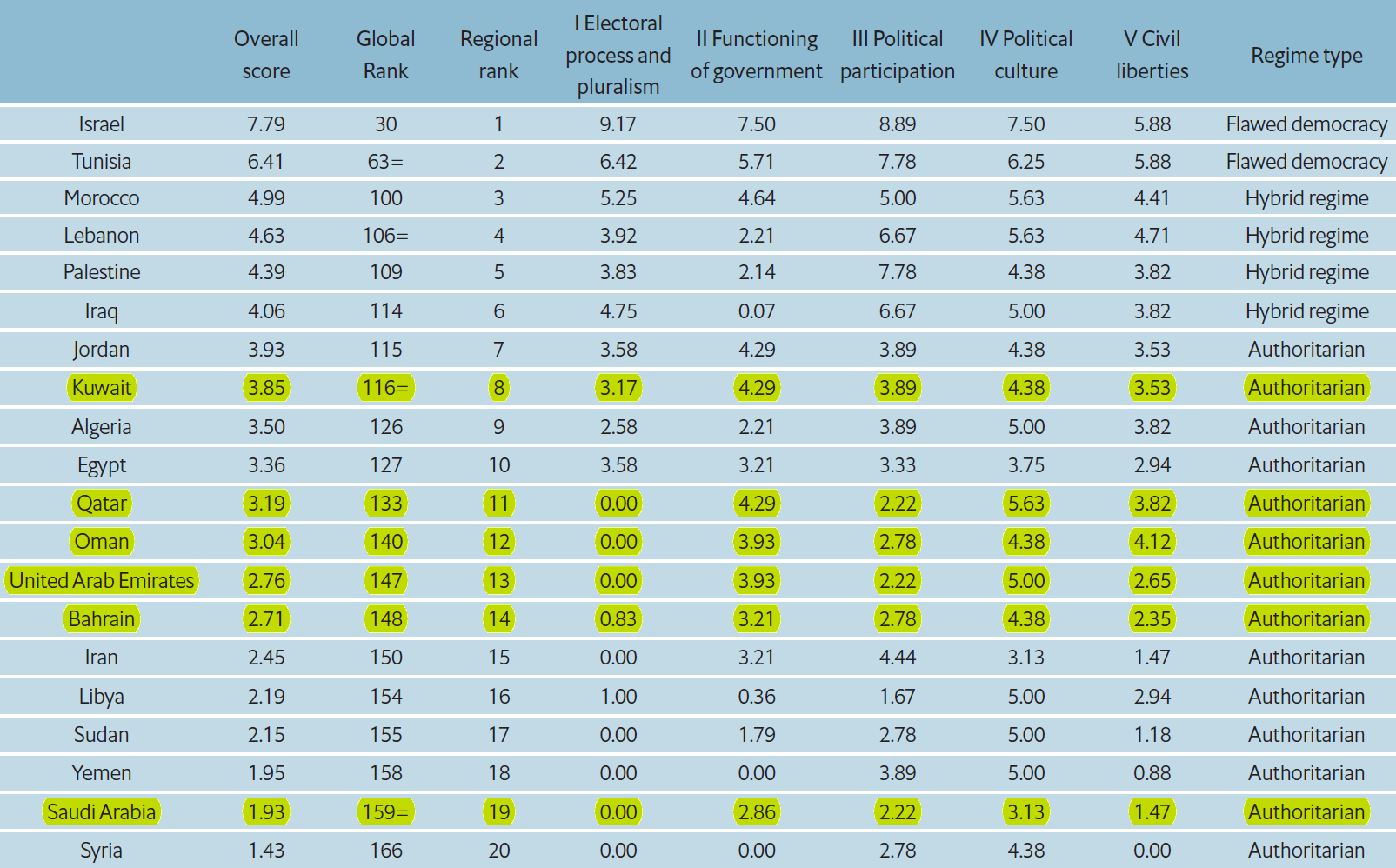
2017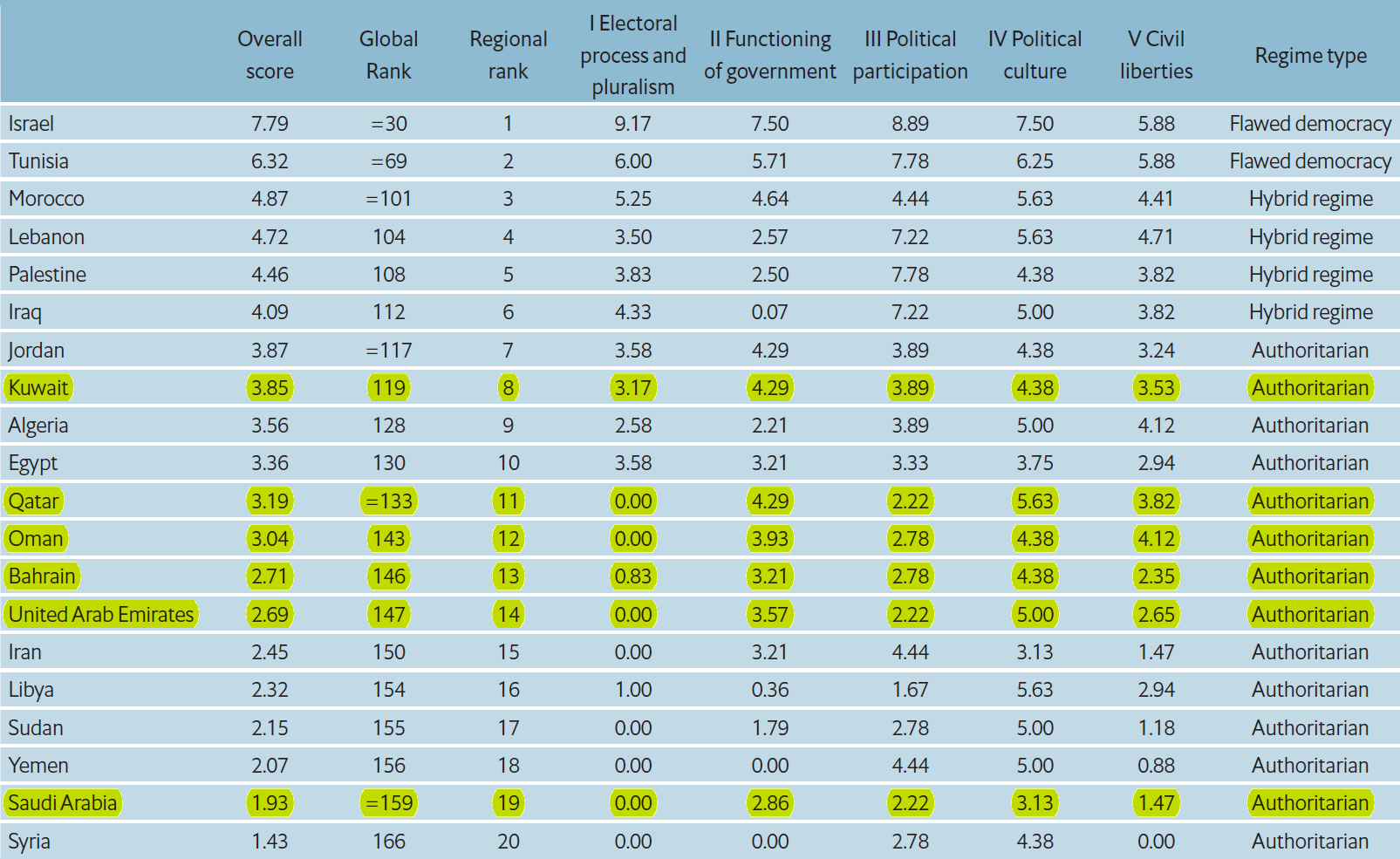
2016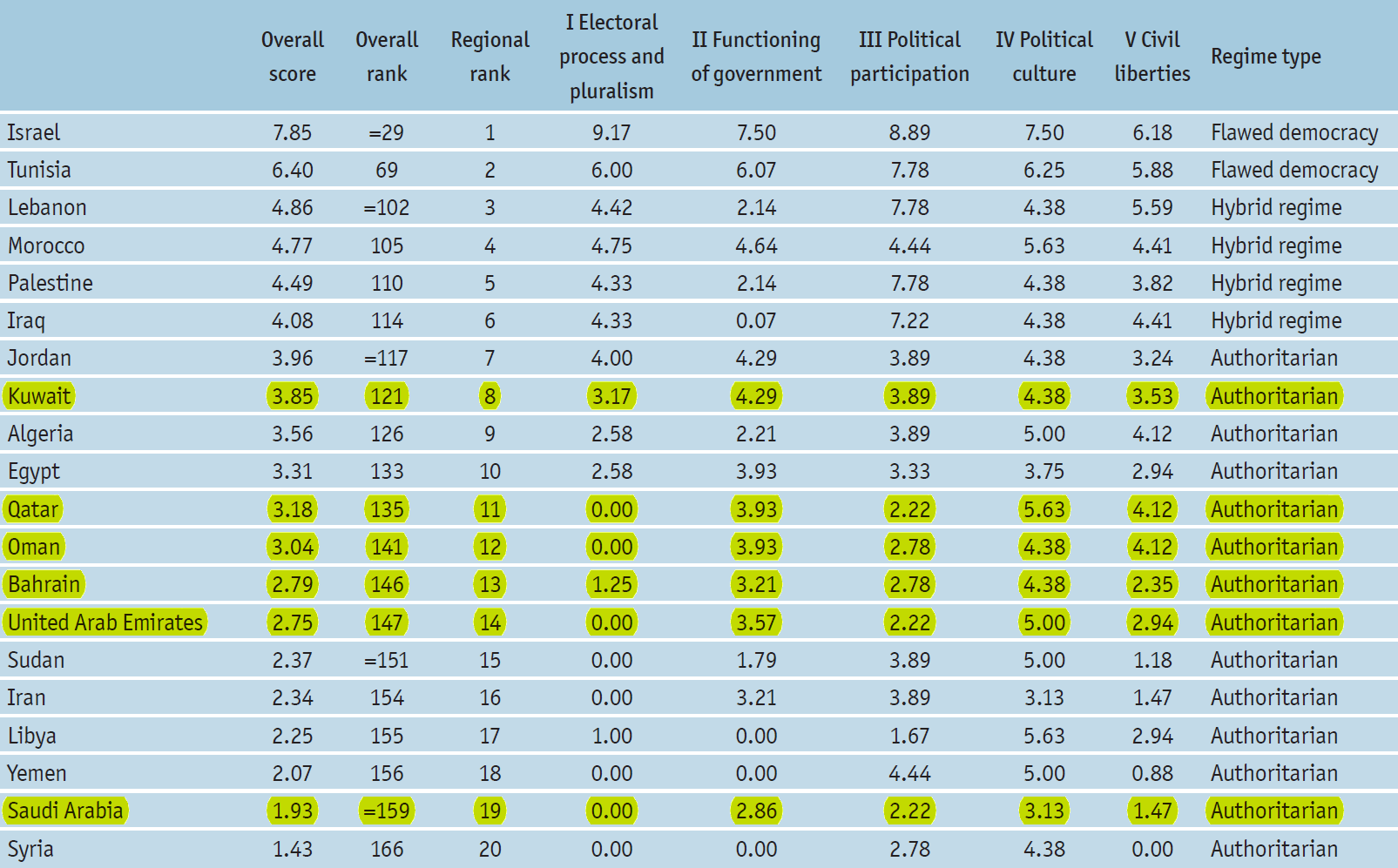
2024, Press Freedom scores
The World Press Freedom Index compares the level of freedom enjoyed by journalists and media in 180 countries and territories. Produced by Reporters Without Borders (Reporters sans frontières; RSF), who, in this regard, define freedom as: “the ability of journalists as individuals and collectives to select, produce, and disseminate news in the public interest independent of political, economic, legal, and social interference and in the absence of threats to their physical and mental safety.”
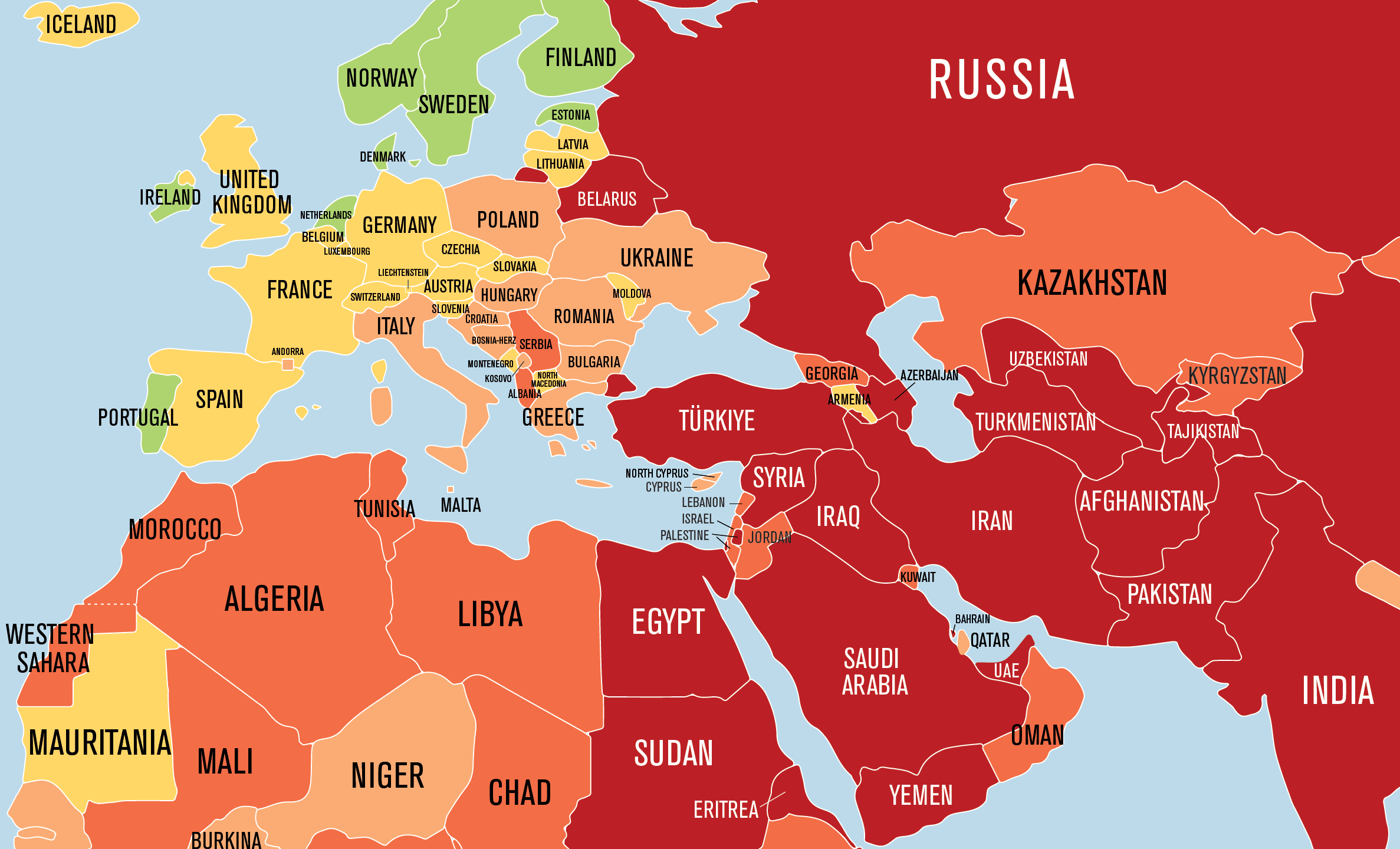

RSF contend that it is the right of every human being to “have access to free and reliable information.” The Press Freedom Index, use five contextual indicators for each economy assessed: political context, legal framework, economic context, sociocultural context and safety (whereby a subsidiary score ranging from 0 to 100 is calculated for each indicator). The following charts are ranked from least to most free, relatively speaking:
Bahrain, Press Freedom scores
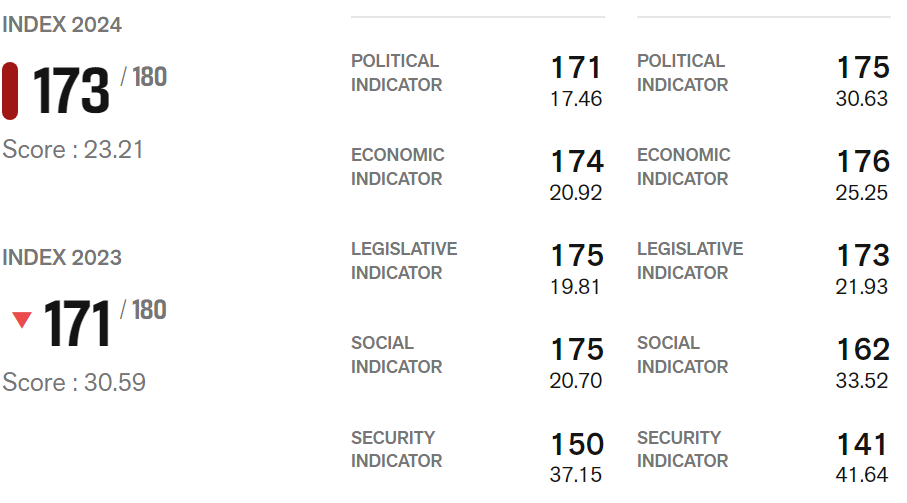
Saudi Arabia, Press Freedom scores
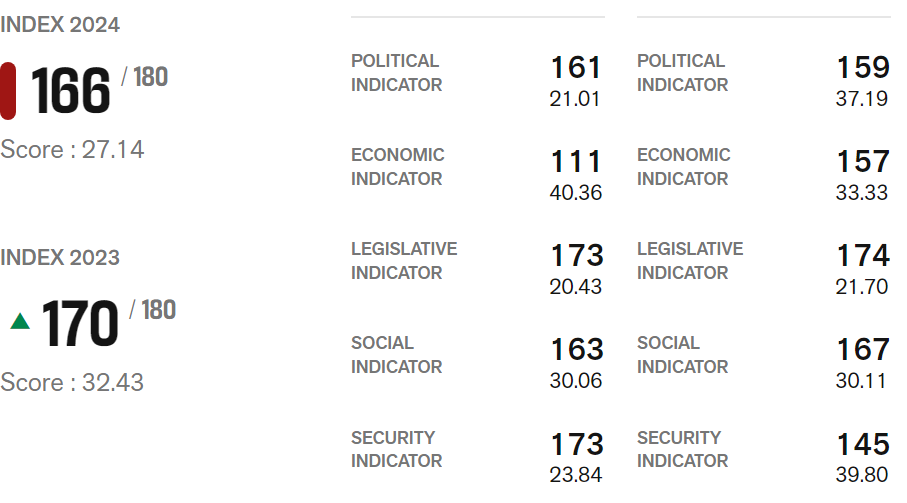
United Arab Emirates, Press Freedom scores
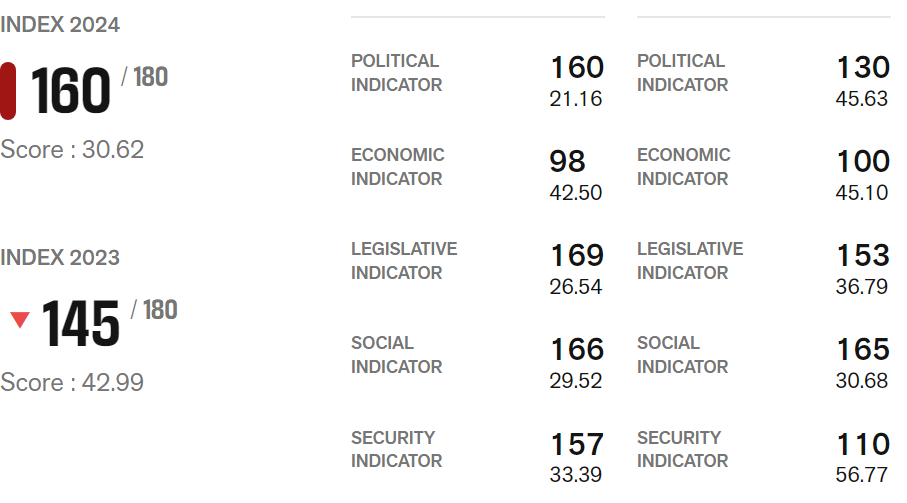
Oman, Press Freedom scores
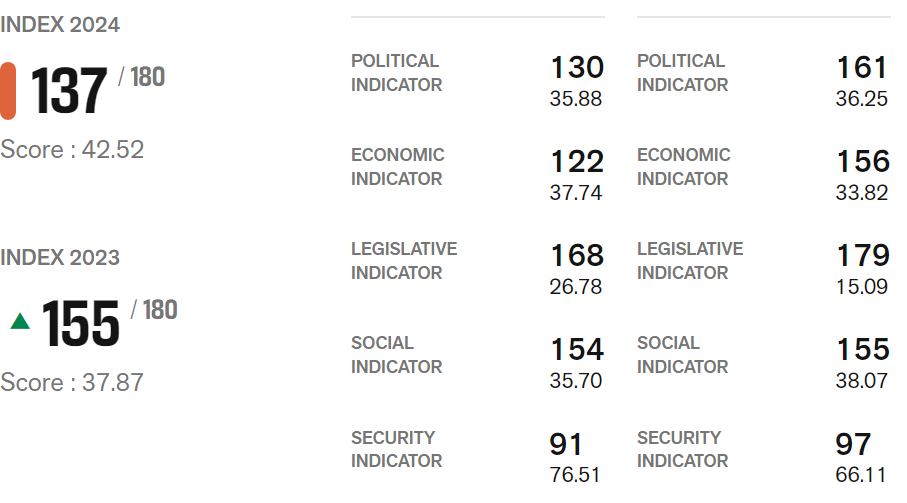
Kuwait, Press Freedom scores
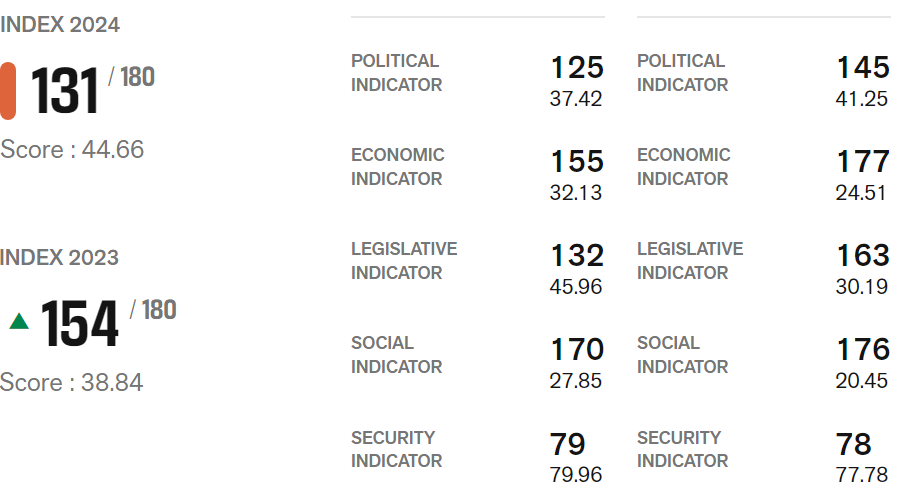
Qatar, Press Freedom scores
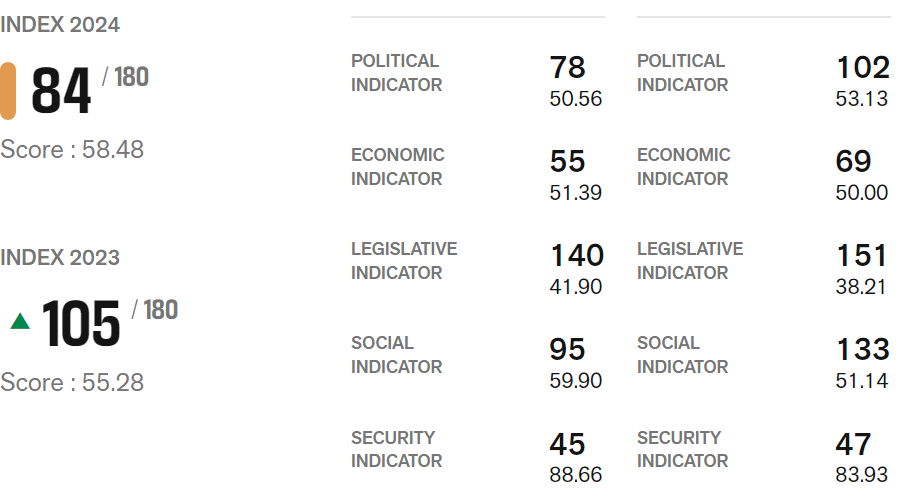
Transformation positions
Bertelsmann Stiftung’s Transformation Index analyses the transformation processes toward democracy and a market economy in international comparison. In 2024 it was stated that the “quality of democracy in developing and transformation countries has been in steady decline over the past 20 years [and] out of the 137 countries on the index the majority are “autocracies” (only 63 are democracies). Across MENA, in transitional economies, “autocratic rule festers” with only Lebanon being considered democratic (albeit a highly defective democracy (BTI, 2024).
BTI (2024) also point out that MENA’s scores for democracy and the quality of governance are at an all-time low [and] the quality of governance is deteriorating, and military forces are gaining power. The German NGO adds that many countries rely on “flashy imagery and marketing under the banner of modernisation,” rather than making actual progress. The following charts are ranked from least to most progressive, relatively speaking:
Saudi Arabia, BTI 2024 scores
Expand Chart →
Oman, BTI 2024 scores
Expand Chart →
Bahrain, BTI 2024 scores
Expand Chart →
Qatar, BTI 2024 scores
Expand Chart →
United Arab Emirates, BTI 2024 scores
Expand Chart →
Kuwait, BTI 2024 scores
Expand Chart →
Fraser Institute rankings
The Fraser Institute’s Human Freedom Index (HFI) presents a broad measure of human freedom, understood as the absence of coercive constraint. Below, the listings are ranked from least to most free, relatively speaking.
Saudi Arabia, Human Freedom Index, 2024 scores
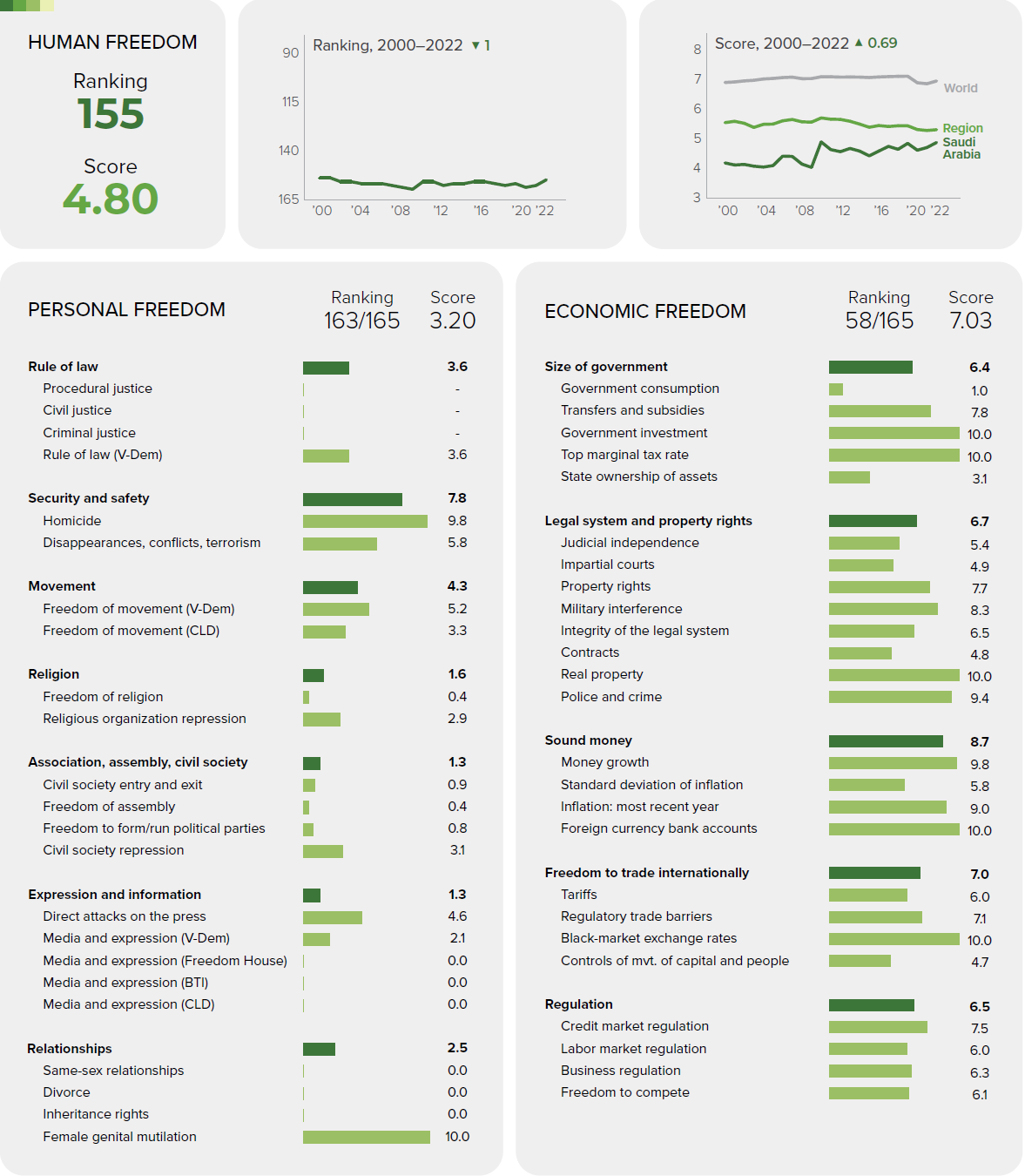
Qatar, Human Freedom Index, 2024 scores
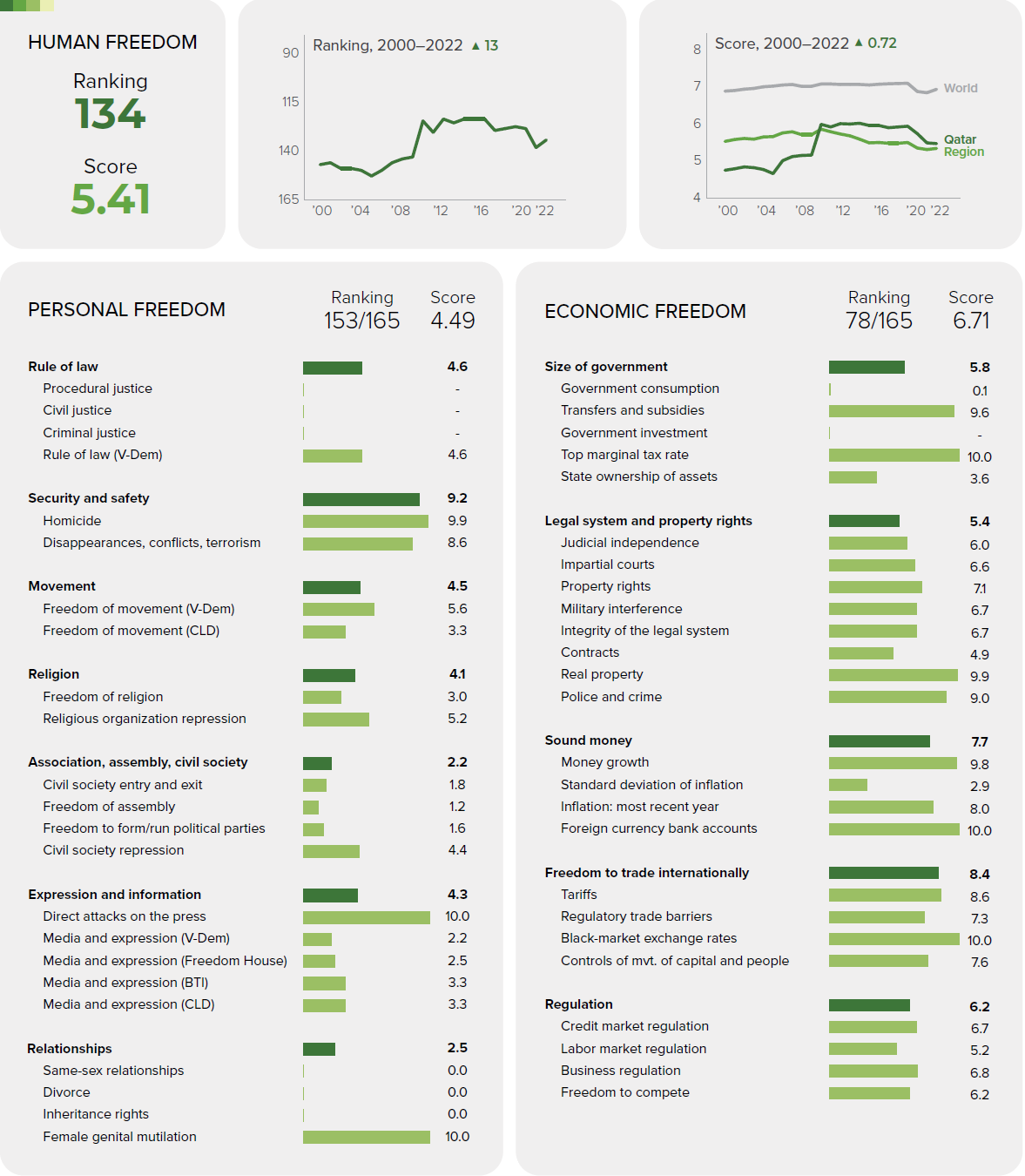
Bahrain, Human Freedom Index, 2024 scores
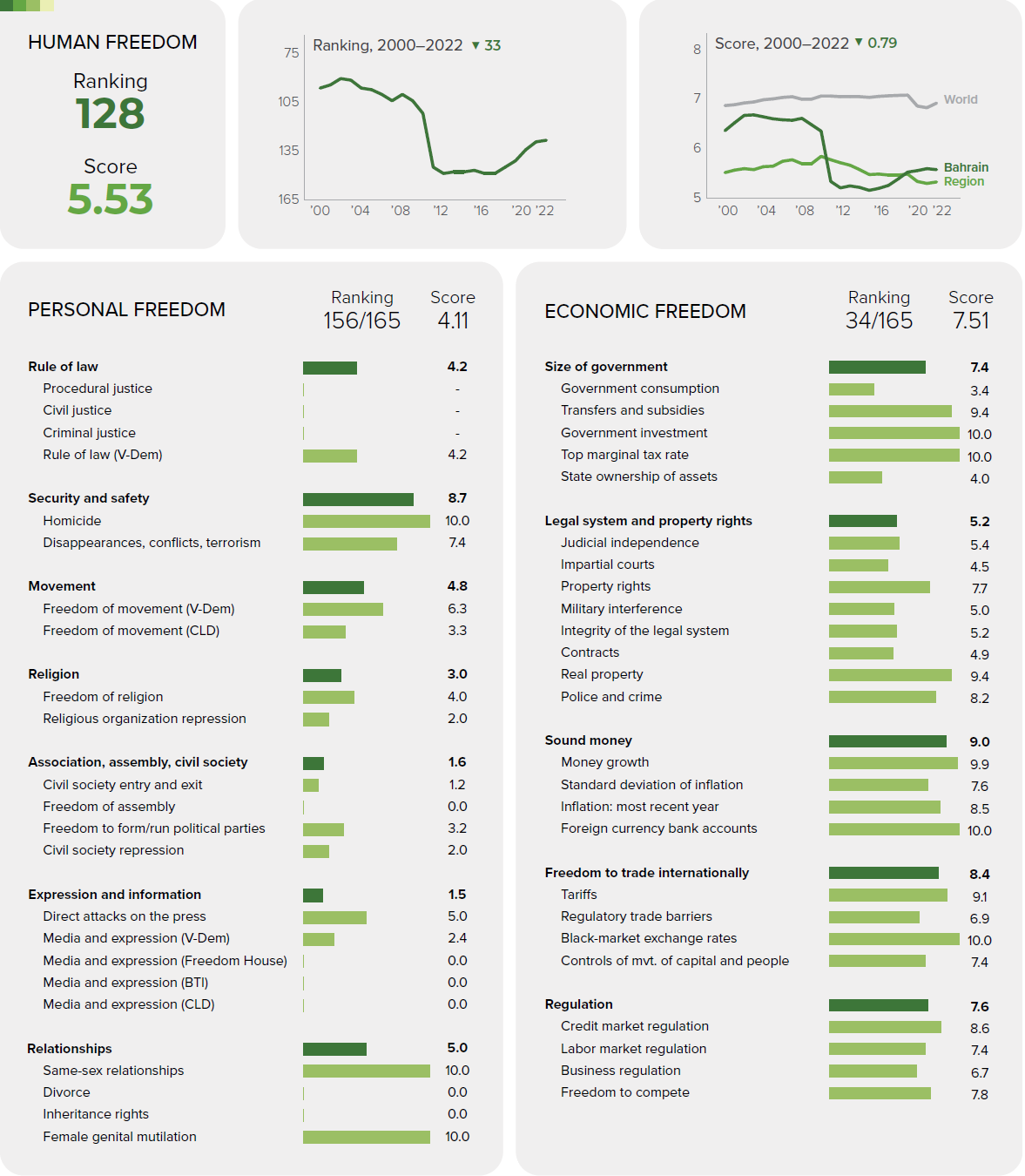
Oman, Human Freedom Index, 2024 scores
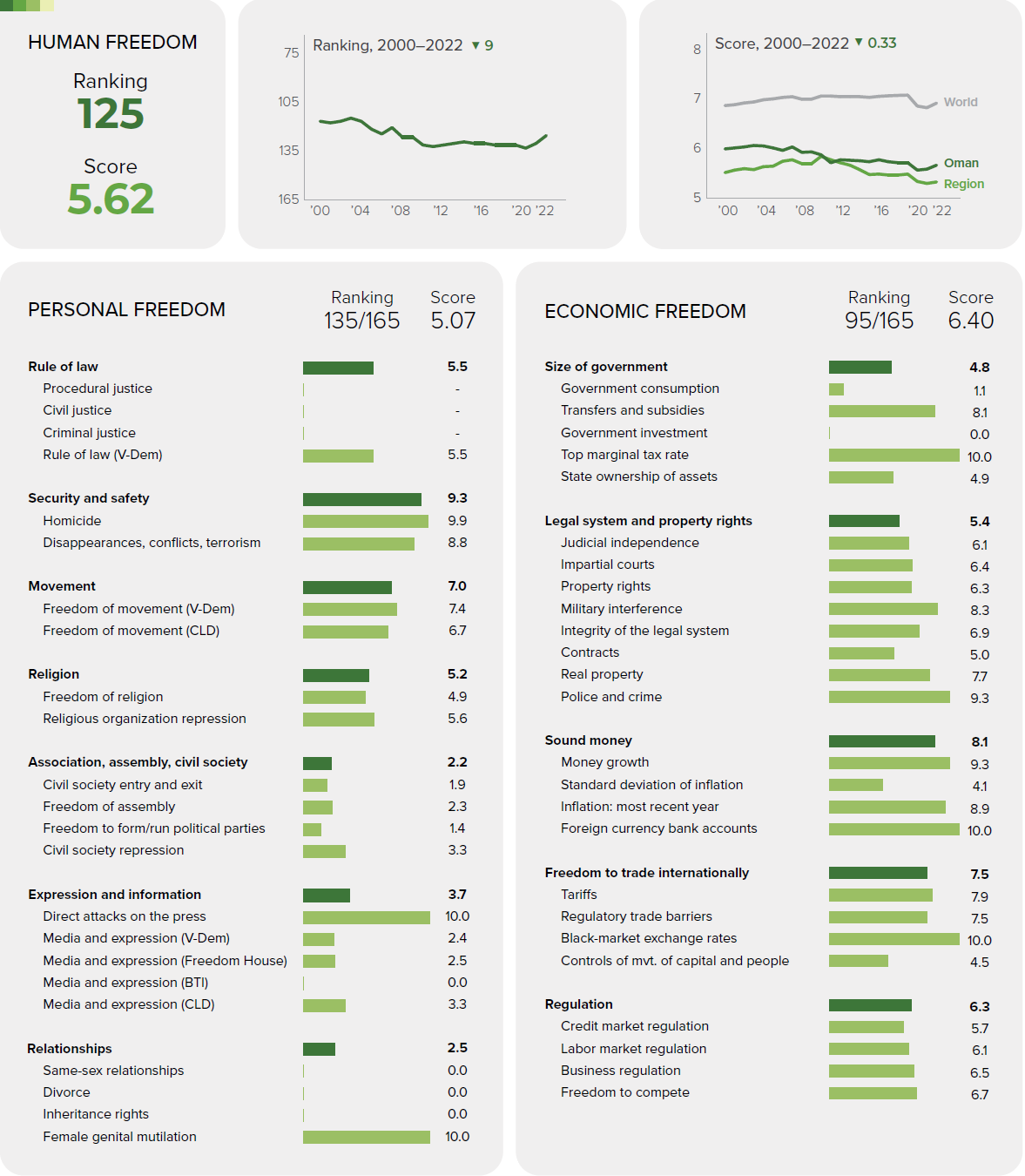
The United Arab Emirates, Freedom in the World, 2024 scores
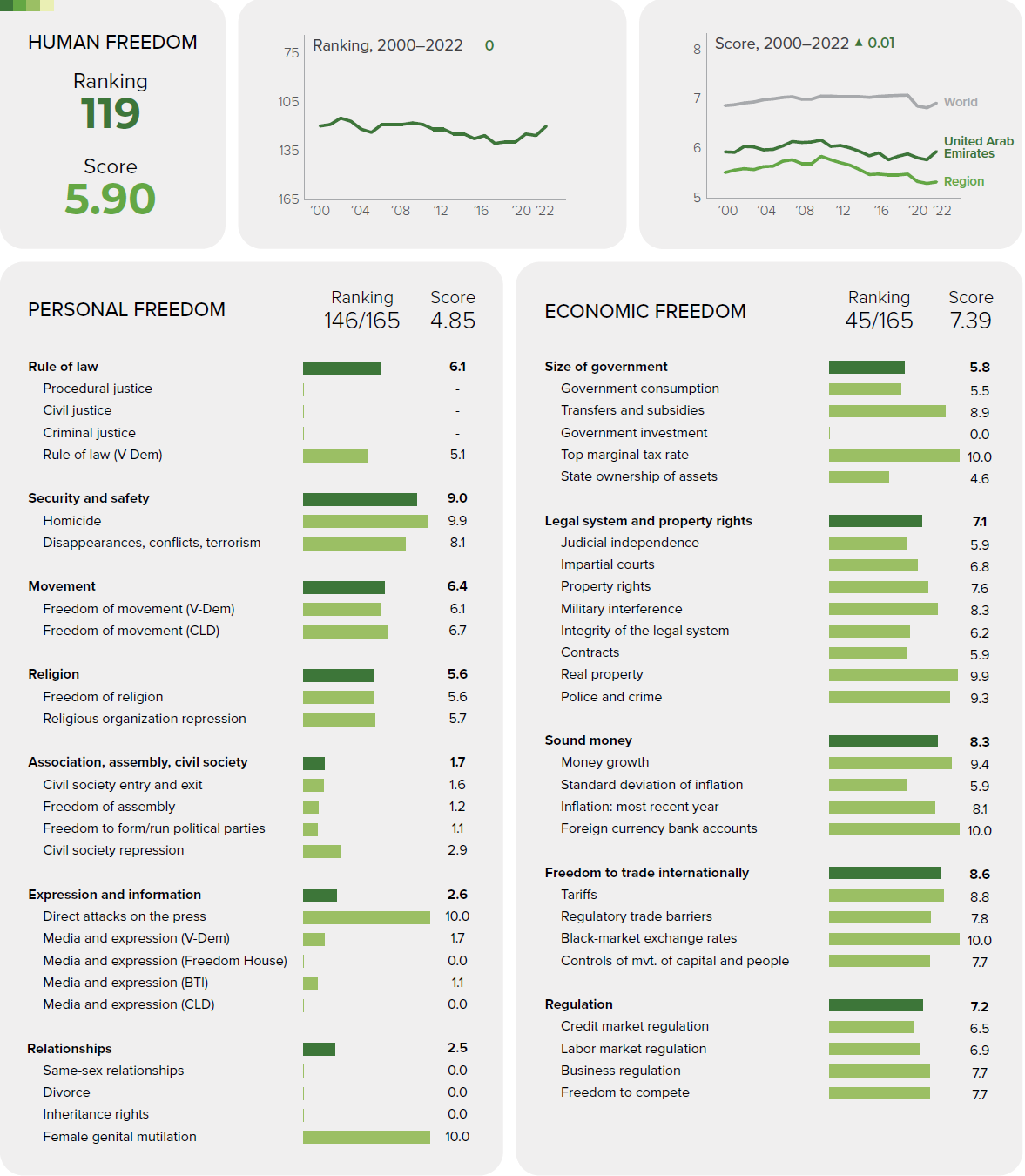
Kuwait, Human Freedom Index, 2024 scores
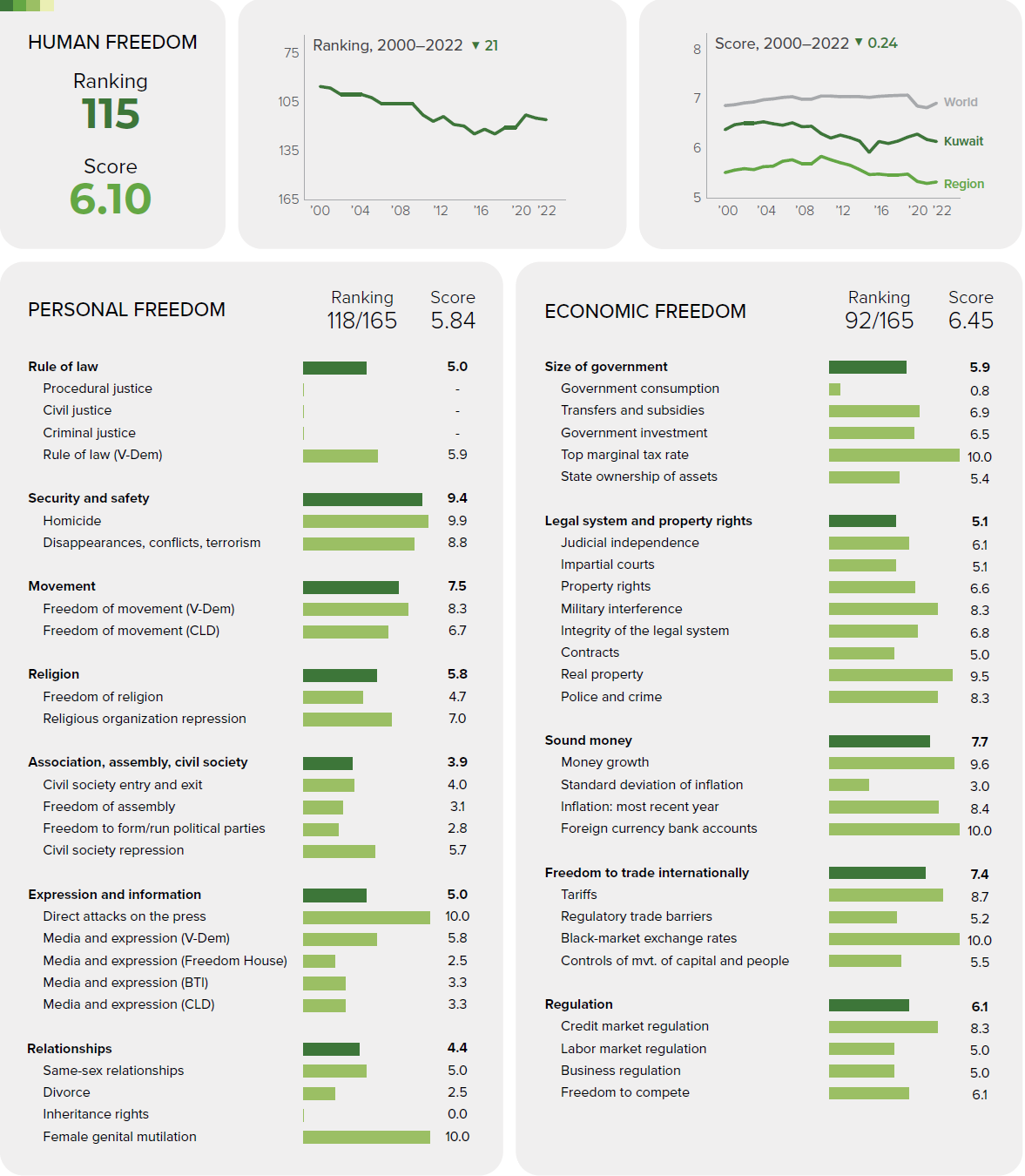
Freedom House rankings
The following Freedom in the World listings are ranked from least free to most free. Freedom House point out that their Freedom in the World annual rankings are “the most widely read and cited report of its kind, tracking global trends in political rights and civil liberties for over 50 years.” They chart Global Freedom scores and Internet Freedom scores for some 210 countries and territories. More latterly, Freedom House have begun to chart Internet Freedom scores (currently 70 countries are tracked, of which three are in the Arabian Gulf: Bahrain, Saudi Arabia and the United Arab Emirates).
Saudi Arabia, Freedom in the World, 2024 scores
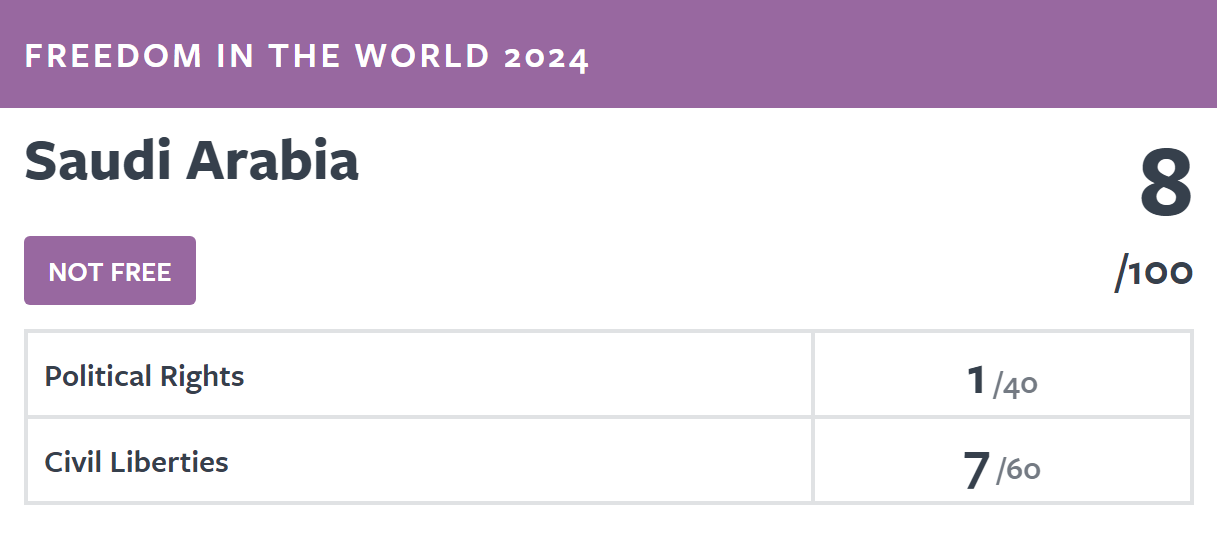
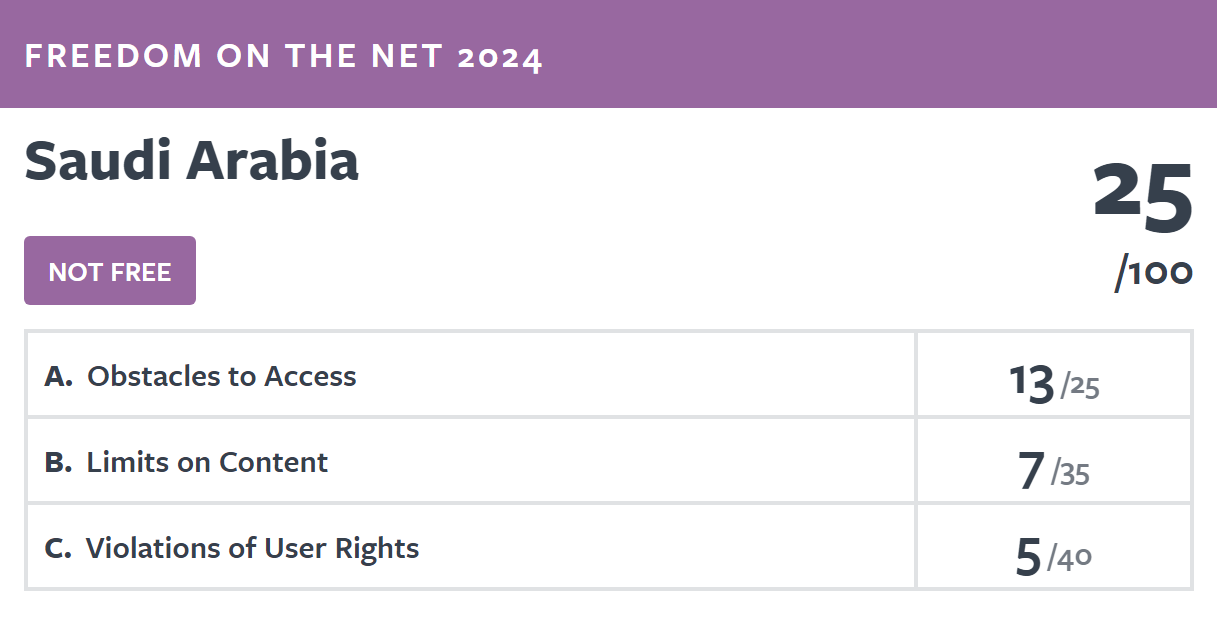
Bahrain, Freedom in the World, 2024 scores
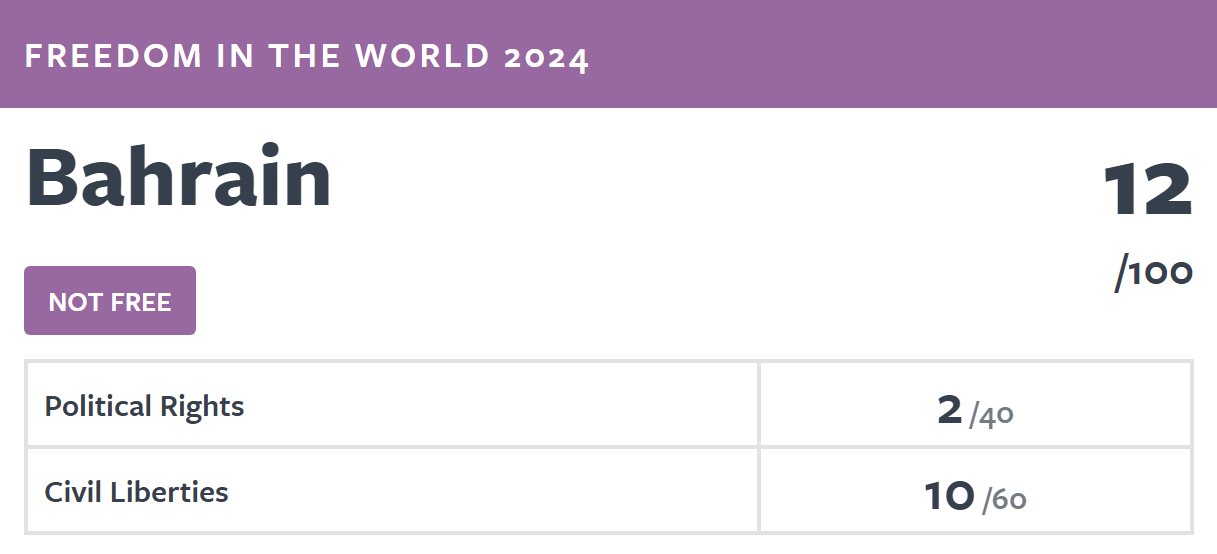
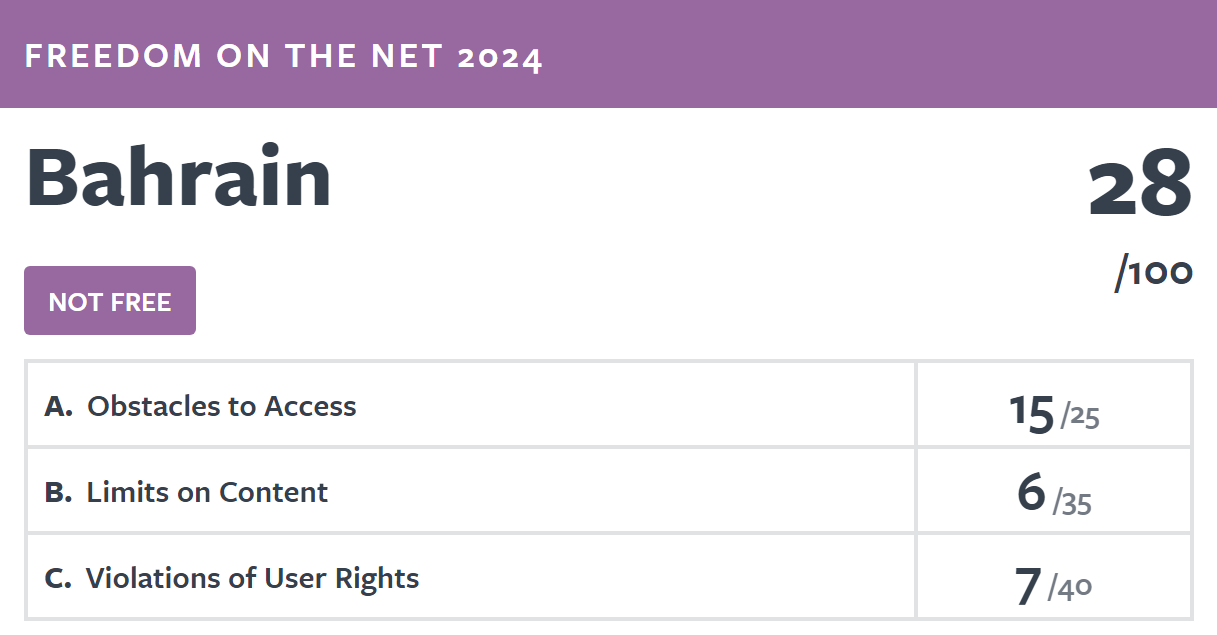
The United Arab Emirates, Freedom in the World, 2024 scores
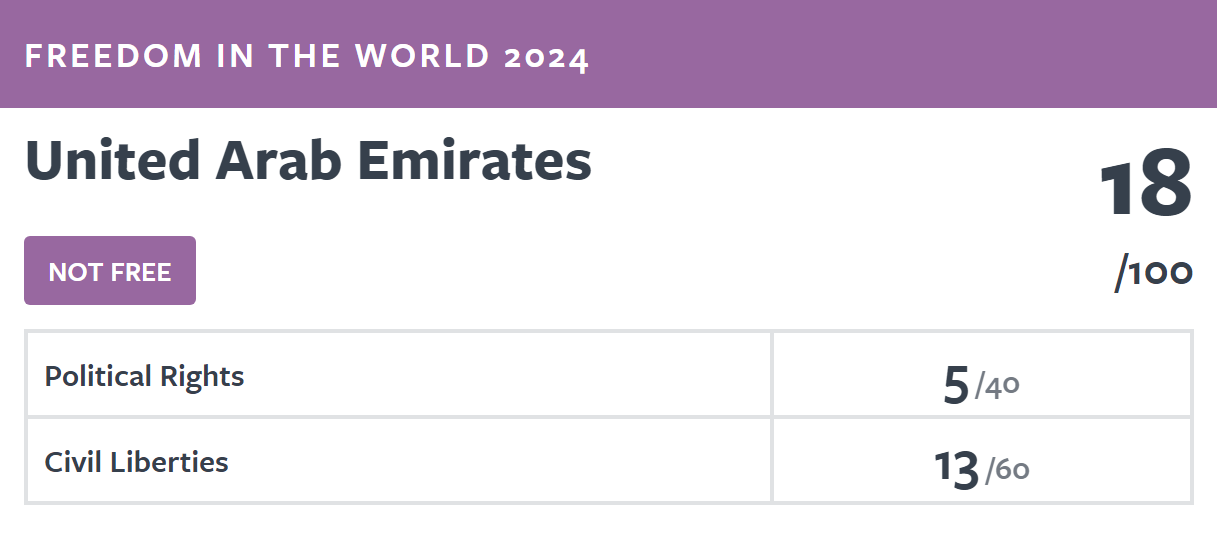
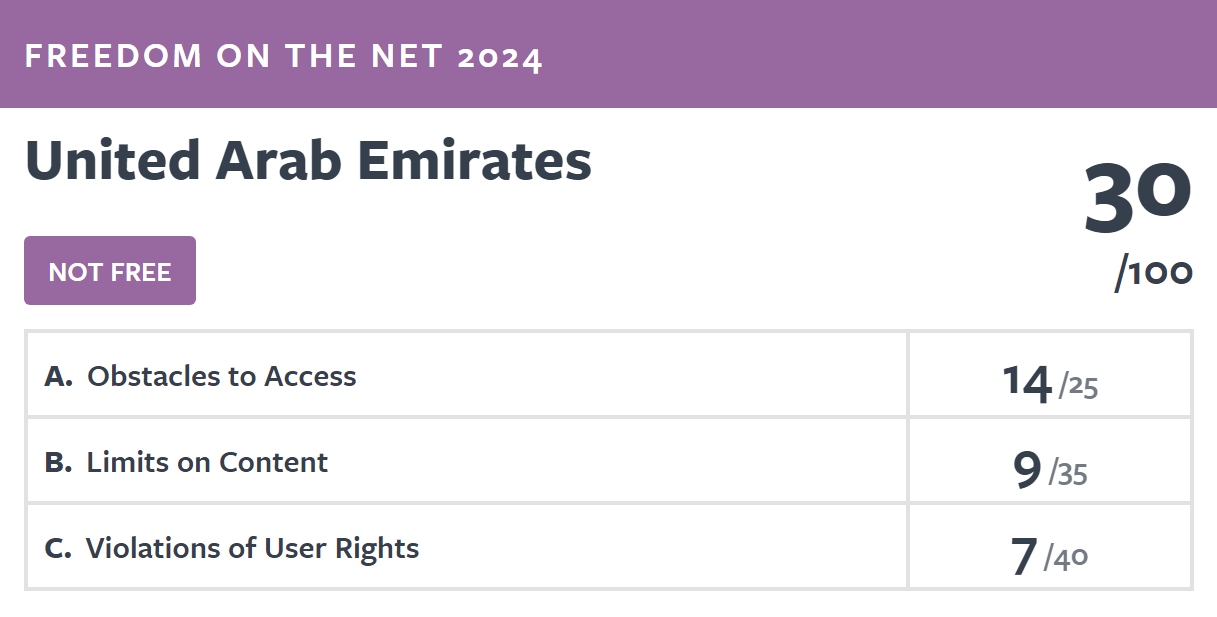
Oman, Freedom in the World, 2024 scores
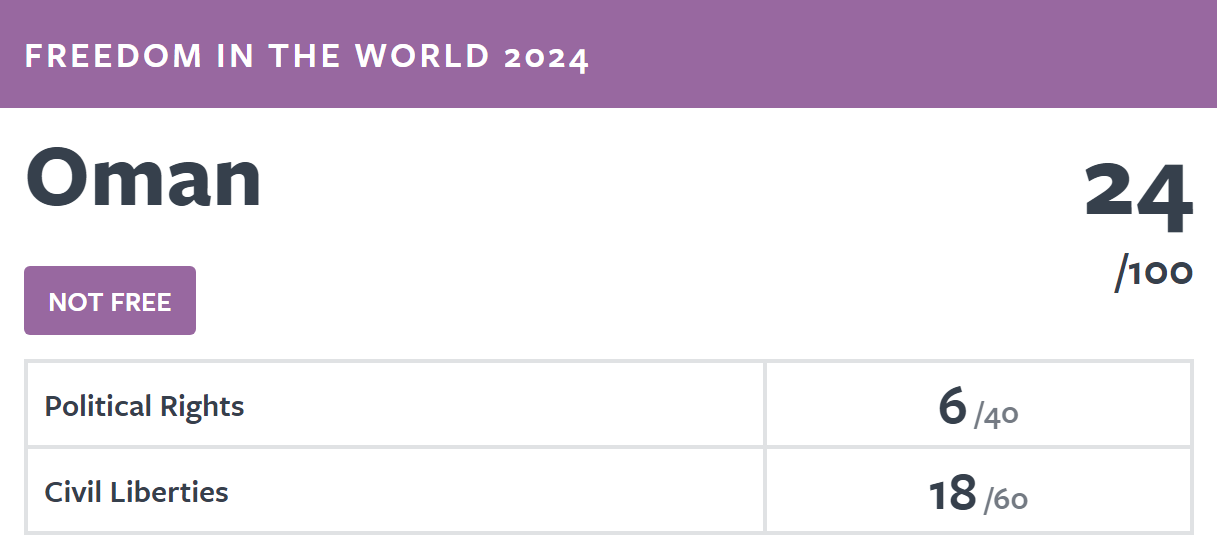
Qatar, Freedom in the World, 2024 scores
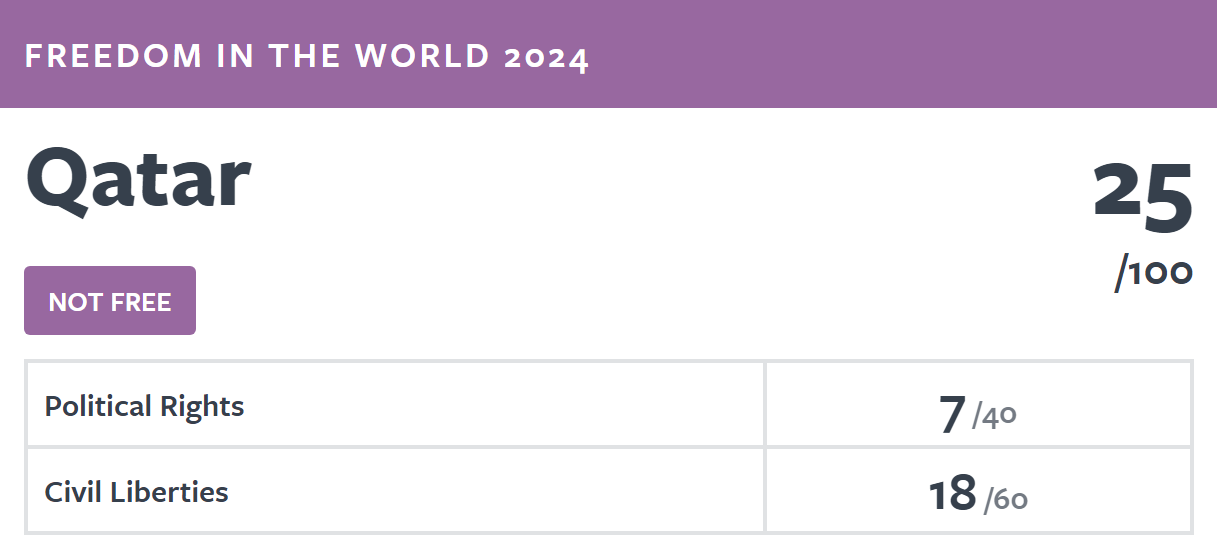
Kuwait, Freedom in the World, 2024 scores
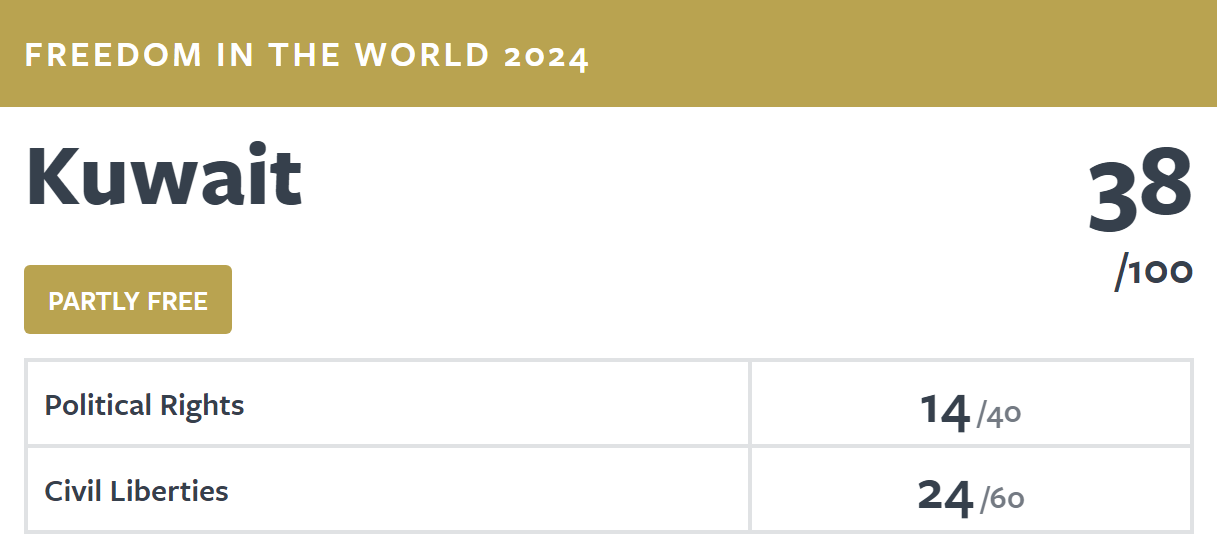
notes
Country profile information is compiled from, amongst others, the following:
Academic
 Cambridge University Press →
Cambridge University Press →
 Intellect Discover →
Intellect Discover →
 Oxford Academic →
Oxford Academic →
 Routledge →
Routledge →
 Sage →
Sage →
 Springer →
Springer →
Media outlets
 The Economist Intelligence Unit →
The Economist Intelligence Unit →
 Financial Times →
Financial Times →
 Middle East Economic Digest →
Middle East Economic Digest →
Organisations
 Arab Monetary Fund →
Arab Monetary Fund →
 Bertelsmann Transformation Index →
Bertelsmann Transformation Index →
 Energy Information Agency →
Energy Information Agency →
 Energy Institute →
Energy Institute →
 Eurostat →
Eurostat →
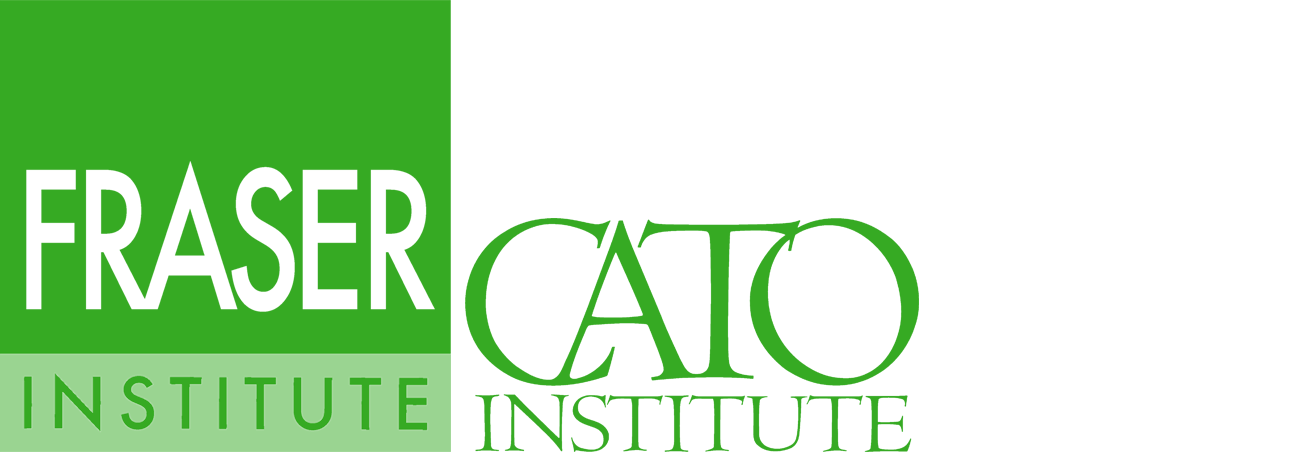 Fraser Institute →
Fraser Institute →
 Freedom House →
Freedom House →
 International Energy Agency →
International Energy Agency →
 International Monetary Fund →
International Monetary Fund →
 Organisation of Petroleum Exporting Countries →
Organisation of Petroleum Exporting Countries →
 Organisation for Economic Co-operation and Development →
Organisation for Economic Co-operation and Development →
 Reporters sans frontières →
Reporters sans frontières →
 United Nations Development Program →
United Nations Development Program →
 Varieties of Democracy →
Varieties of Democracy →
 The World Bank →
The World Bank →
 World Economic Forum →
World Economic Forum →
 World Intellectual Property Organisation →
World Intellectual Property Organisation →
 World Trade Organisation →
World Trade Organisation →
On each of the six country profile pages full reference information is provided:
 |
 |
 |
 |
 |
 |
Selected references
Filiu, J.-P. (2014). Gaza: A History. Oxford University Press.
Hourani, A. (1991). A History of the Arab Peoples. Faber & Faber.
Mackintosh-Smith, T. (2019). Arabs. Yale University Press.
McHugo, J. (2013). A Concise History of the Arabs. Saqi Books.
McHugo, J. (2017). A Concise History of Sunnis and Shias. Saqi Books.
| i | This is the website of Dr Emilie J. Rutledge who, with almost two decades’ worth of experience in managing, designing and delivering university-level economics courses, is currently Head of the Economics Department at The Open University.
 erutledge.com  Dr Emilie J. Rutledge Emilie has published over 20 peer-reviewed papers and is the author of “Monetary Union in the Gulf.” Her current research focus is on employability, the feasibility of universal basic incomes and, the oil-rich Arabian Gulf’s economic diversification and labour market reform strategies. On an ad hoc basis, Emilie provides consultancy on developing interactive university courses, alongside analytical insight on the political-economy of the Arabian Gulf. |

 Elsevier
Elsevier